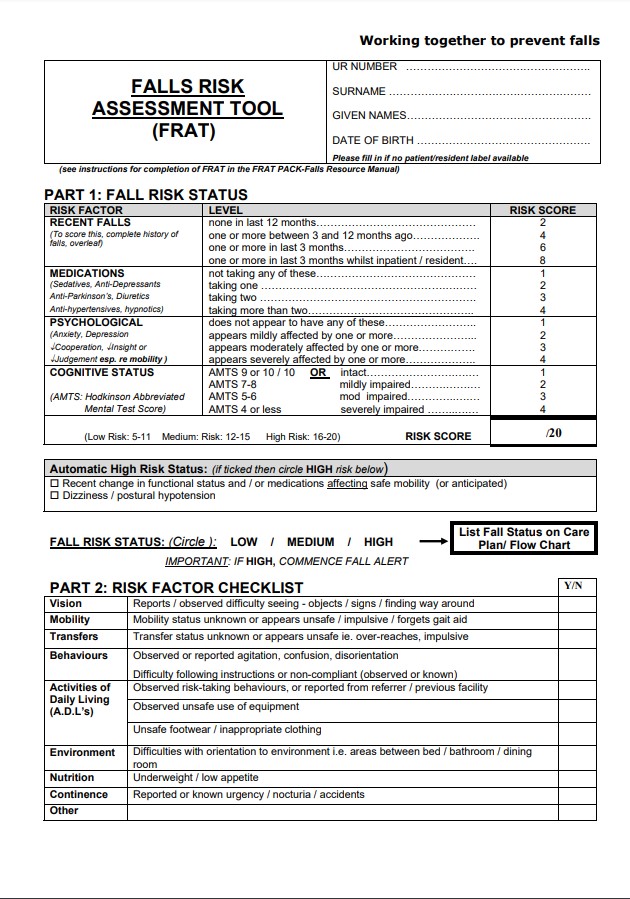Getting My Dementia Fall Risk To Work
Dementia Fall Risk - An Overview
Table of ContentsSome Known Incorrect Statements About Dementia Fall Risk The Only Guide for Dementia Fall RiskAll About Dementia Fall RiskNot known Facts About Dementia Fall RiskNot known Incorrect Statements About Dementia Fall Risk
You might be nervous since you have actually had an autumn prior to or because you've discovered you're starting to feel unsteady on your feet. You may have observed modifications to your health and wellness, or simply really feel like you're reducing down a little. Whatever the factor, it isn't uncommon to end up being careful and lose confidence, and this can stop you doing the important things you utilized to do and make you feel more isolated.If you've had a fall or you've begun to really feel unsteady, inform your medical professional also if you feel fine or else. Your doctor can check your balance and the method you stroll to see if improvements can be made. They may be able to refer you for a drops risk evaluation or to the falls prevention solution.
This details can be obtained through interviews with the person, their caretakers, and an evaluation of their medical records. Begin by asking the individual concerning their background of falls, consisting of the frequency and scenarios of any type of recent drops. Dementia Fall Risk. Ask about any movement problems they might experience, such as unsteady or trouble strolling
Conduct an extensive review of the person's medications, paying certain attention to those known to raise the danger of drops, such as sedatives or medications that lower blood stress. Figure out if they are taking multiple drugs or if there have been recent modifications in their medication program. Assess the individual's home environment for possible hazards that can increase the threat of falls, such as inadequate lighting, loose carpets, or absence of grab bars in the washroom.
Facts About Dementia Fall Risk Uncovered
Overview the individual through the autumn threat assessment type, clarifying each question and videotaping their reactions precisely. Ensure that the individual understands the function of the analysis and really feels comfy providing truthful solutions. Determine the overall danger rating based upon the feedbacks supplied in the assessment form. Identify the individual's threat category (low, medium, or high) based on the complete rating and the existence of automatic risky standing elements.
This plan may include exercise programs to boost stamina and equilibrium, medication adjustments, home alterations, and referrals to various other experts as needed. Routinely keep track of the person's progress and reassess their danger of falls as needed. Customize the care plan based upon modifications in their wellness standing or home atmosphere. Offer ongoing education and learning and support to advertise safety and security and reduce the threat of falls in their everyday living activities.
Numerous researches have revealed that physical therapy can assist to lower the risk of falling in adults ages 65 and older. In a new research study (that looked at falls threat in women ages 80 and older), researchers determined the financial visit this page impact of selecting physical treatment to stop falls, and they discovered that doing so conserves $2,144, consisting of all the covert expenses of your time, discomfort, missed out on life occasions, and the bucks spent for solutions.
Dementia Fall Risk Can Be Fun For Anyone
Assessing your equilibrium, strength, and strolling ability. A home safety assessment. Based on the assessment results, your physical specialist will develop a strategy that is customized to your particular needs.
Older grownups who have difficulty strolling and speaking at the same time go to a higher risk of dropping. Dementia Fall Risk. To help increase your safety and security during day-to-day activities, your physical therapist might develop a training program that will test you to keep standing and strolling while you do another job. Examples consist of strolling or standing while counting in reverse, having a conversation, or carrying a bag of grocery stores
Establish objectives for enhancing their physical task. Exercise much more to increase their stamina and equilibrium. These programs typically are led by volunteer trains.
6 Simple Techniques For Dementia Fall Risk

Measles, or rubeola, is an extremely contagious, severe viral transmittable disease brought on by the measles infection. Some individuals think about measles as simply a breakout and fever that improves in a use this link couple of days; nonetheless, measles can cause major health and wellness complications, especially in kids more youthful than 5-years-old. The very best protection against measles is the measles, mumps, and rubella (MMR) injection.
Loss are an usual cause of injury among older adults. According to the CDC, in one year alone, fall-related injuries added to over $50 billion in medical costs (Dementia recommended you read Fall Risk). In healthcare facility settings, older adults are at especially high danger of drops due to the fact that their decreased flexibility from being constrained to an area or bed.
The Of Dementia Fall Risk

She has no background of falls, her stride is stable, and she voids with no concerns. The previous registered nurse states that she calls for support to the bathroom when she requires to go.
Examples of common loss interventions/measures consist of: Making sure a client's important things are within reach. Placing the client's bed rails up with the alarm system on. Helping a patient while they're standing up from bed. Beyond recognizing exactly how to use the Johns Hopkins Autumn Risk Evaluation Tool, it is very important that facilities integrate its use right into a more detailed loss prevention strategy.